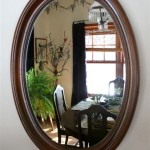Black Aged Mirror: Aesthetic Depth and Historical Resonance
Black aged mirror, also known as antique black mirror or dark antique mirror, represents a distinct and sophisticated design element in interior decoration. Its appeal lies in its subtle reflectivity combined with a sense of history and depth, providing a unique visual texture that standard mirrors lack. This article will explore the characteristics, creation process, applications, and maintenance considerations associated with black aged mirror.
The inherent characteristics of black aged mirror set it apart from traditional or clear mirrors. While conventional mirrors provide a direct and accurate reflection, black aged mirror softens and subtly distorts the reflected image, resulting in a softer, more diffused aesthetic. The dark tint, which can range from a deep charcoal to a lighter smoky gray, diminishes the intensity of light reflection, creating a calming and subdued atmosphere. The "aging" process introduces imperfections, such as mottled patterns, variations in tone, and subtle spotting, mimicking the appearance of a mirror that has aged naturally over time. This combination of darkness and artificial aging renders each sheet of black aged mirror unique, contributing to its desirability in high-end design applications.
The manufacturing of black aged mirror is a multi-stage process that requires precise control and skilled craftsmanship. The base material is typically float glass, chosen for its flatness and uniformity. The initial step involves applying a dark tint to the back of the glass. This can be achieved through various methods, including silvering tinted glass or applying a dark-colored coating to standard silvered glass. The key to achieving the aged effect lies in the subsequent controlled corrosion or etching of the silver layer. This process is carefully managed to create the desired level of distressing without compromising the structural integrity of the mirror. Acids or other chemical agents are selectively applied to the silver layer, resulting in the characteristic mottled and spotted appearance. The process must be precise, as over-etching can lead to complete removal of the silver, while insufficient etching will not produce the desired aged aesthetic. Finally, a protective coating is applied to the back of the mirror to prevent further corrosion and ensure its longevity.
Aesthetic and Design Applications
The versatility of black aged mirror allows for diverse applications across various interior design styles. In contemporary spaces, it can provide a striking contrast against clean lines and minimalist décor, adding a touch of drama and sophistication. In more traditional settings, black aged mirror complements antique furniture and rich color palettes, reinforcing a sense of historical authenticity. The subdued reflectivity makes it suitable for use in areas where bright, direct reflections might be undesirable, such as bedrooms or relaxation rooms. Its dark tone lends itself to creating a sense of intimacy and seclusion, transforming larger spaces into more inviting and cozy environments.
Black aged mirror is frequently employed as a decorative wall covering, either in large panels or smaller, geometrically arranged sections. It can be used to create accent walls, backsplashes, or even entire mirrored surfaces, adding depth and visual interest to a room. The subtle reflections and aged imperfections create a dynamic interplay of light and shadow, enhancing the perceived spaciousness of the area. The unique texture of black aged mirror ensures that it functions as a visual art piece in itself, complementing and enriching the overall design scheme.
Beyond wall applications, black aged mirror finds purpose in furniture design. It can be incorporated into table tops, cabinet doors, and dresser panels, immediately elevating the perceived quality and sophistication of the piece. The darkened surface minimizes reflections, ensuring that the furniture remains visually grounding rather than overwhelming the space. The antique effect adds a sense of history and character, lending a unique personality to each piece of furniture. Similarly, black aged mirror is frequently used in decorative accessories, such as trays, picture frames, and vanity mirrors, to add a touch of elegance and refinement to smaller details within the room.
Functional and Practical Considerations
While black aged mirror excels in aesthetics, it is important to consider its functional limitations compared to standard mirrors. The dark tint and aged texture inherently reduce its reflective quality. Therefore, it is generally not recommended for applications where accurate or bright reflections are essential, such as in bathrooms for applying makeup or in dressing rooms for assessing clothing fit. In spaces where black aged mirror is used, supplementary lighting may be necessary to compensate for the reduced reflectivity and ensure adequate illumination.
When selecting black aged mirror, it is crucial to assess the quality of the aging process. The goal is to achieve a natural and aesthetically pleasing aged effect, rather than a haphazard or artificial appearance. Look for variations in tone and texture that appear organic and well-integrated, rather than jarring or inconsistent. The level of distressing should be subtle enough to enhance the visual appeal without compromising the structural integrity of the mirror. It is also important to ensure that the edges of the mirror are properly finished and sealed to prevent moisture infiltration, which could lead to further corrosion or delamination of the silver layer.
The thickness of the glass used in black aged mirror is a crucial factor to consider, especially for larger applications. Thicker glass provides greater strength and stability, minimizing the risk of breakage or warping. For wall coverings or furniture surfaces, a minimum thickness of 6mm is generally recommended, while larger panels may require even thicker glass. The choice of glass thickness will also depend on the specific installation method and the level of support provided. Consulting with a qualified glazier or installer is essential to determine the appropriate glass thickness for each application.
Installation and Maintenance
Proper installation is crucial to ensuring the longevity and aesthetic appeal of black aged mirror. The method of installation will depend on the specific application, but generally involves adhering the mirror to a stable and level surface using specialized mirror adhesive. For larger panels, mechanical fixings, such as mirror clips or screws, may be necessary to provide additional support. It is essential to use adhesives that are specifically formulated for mirrors, as other types of adhesives can damage the silver backing and lead to discoloration or delamination. The surface onto which the mirror is being applied should be clean, dry, and free of any loose particles or contaminants.
Maintaining black aged mirror requires gentle cleaning practices to avoid damaging the delicate surface. Harsh chemicals, abrasive cleaners, and scouring pads should be strictly avoided, as they can scratch or etch the glass and further compromise the aged finish. The recommended cleaning method involves using a soft, lint-free cloth dampened with a mild glass cleaner or a mixture of water and white vinegar. Avoid spraying the cleaner directly onto the mirror surface, as this can cause streaking or water damage. Instead, spray the cleaner onto the cloth and gently wipe the mirror in a circular motion. Dry the mirror thoroughly with a clean, dry cloth to prevent water spots.
In environments with high humidity, such as bathrooms or kitchens, it is important to ensure adequate ventilation to prevent condensation from forming on the mirror surface. Prolonged exposure to moisture can accelerate the corrosion process and lead to further deterioration of the aged finish. Using a dehumidifier or opening windows after showering or cooking can help to reduce humidity levels and protect the mirror. Regular inspections should be conducted to check for any signs of damage, such as cracks, chips, or delamination. Promptly addressing any such issues can prevent further damage and extend the lifespan of the black aged mirror.
The Enduring Appeal of Black Aged Mirror
Despite the availability of numerous modern materials and design trends, black aged mirror continues to hold a significant place in the world of interior design. Its unique combination of aesthetic depth, historical resonance, and subtle reflectivity makes it a versatile and timeless choice for a wide range of applications. The darkened surface and aged imperfections create a sense of character and authenticity that is difficult to replicate with other materials. Whether used as a wall covering, furniture adornment, or decorative accessory, black aged mirror adds a touch of elegance and sophistication to any space.
The process of creating black aged mirror is a meticulous craft, requiring skilled artisans and precise control over the aging process. The resulting product is a unique and visually striking material that enhances the aesthetic appeal of any interior. Its ability to soften reflections, create depth, and add a sense of history makes it a valuable asset for designers and homeowners alike. Careful consideration of its functional limitations, proper installation, and gentle maintenance practices will ensure that black aged mirror continues to enrich and transform spaces for years to come.
Benefits of Using Black Aged Mirror
The use of black aged mirror offers several distinct advantages in interior design projects. Its nuanced reflections provide a softer, more inviting atmosphere compared to the stark reflections of standard mirrors. This makes it particularly suitable for creating relaxing and intimate spaces. The inherent imperfections introduce a unique textural element, adding visual interest and preventing the mirror from appearing overly sterile or clinical. Furthermore, the dark tint can effectively mask minor imperfections on walls or furniture, contributing to a more polished and refined overall aesthetic. The aged appearance also lends a sense of history and character to the space, making it feel more lived-in and authentic.

Antique Mirror W Black Frame Glass Diy

The Annecy Mirror Matt Black 6ft 299 00 Mirrors Cau Luxury Furniture And Rococo Reion Antique Baroque French Style Specialist
Gallery Harrelson Antique Black Wall Mirror Very

Black Mercury From The Antique Mirror Classic Finishes Portfolio Ellison Art Glass

Large Antique Black Shabby Chic Ornate Decorative Wall Mirror

Black Large French Overmantle Vintage Period Ornate Statement Wall Mirror 5ft

Black Metal Aged Mirror Forhaus Design

Antiqued Mirror Effect Thicketworks

Baroque Mirror Goya Silver With Black Classic Mirrors Usi Maison

Black Ornate Antique Carved Mirror 25 8x37 In Kirklands Home








